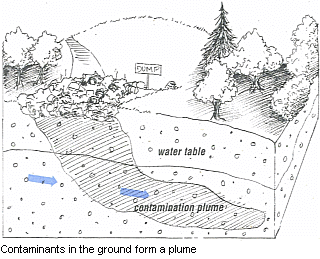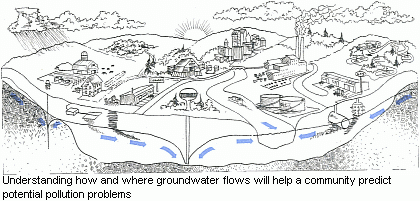Groundwater Contamination
 Now that you know a little about groundwater - how it moves and flows, where it is found, how it is tapped - a look at what can contaminate it is necessary. For if we wish to tap the earth for its water, we must take care with what we discard and release into the ground; what happens above can affect the water below.
Now that you know a little about groundwater - how it moves and flows, where it is found, how it is tapped - a look at what can contaminate it is necessary. For if we wish to tap the earth for its water, we must take care with what we discard and release into the ground; what happens above can affect the water below.
While it’s true that groundwater can be rendered non-potable by naturally occurring substances (e.g., radon, sulfates, iron), man–made chemicals are the primary source. Soil can effectively filter organic materials, such as domestic sewage, from reaching aquifers and wells, but many chemicals are resistant to dilution and degradation and therefore can persist in soils and groundwaters for a long time.
In general, liquid contaminants aren’t dispersed and diluted in groundwater as much as they are in surface water and, like groundwater itself, they move slowly. A concentrated form of liquid contaminants is called a contamination plume. Often, a plume flows in the same path as the surrounding groundwater.
The figure below shows a representative geologic cross section of Connecticut and some human activities that can harm groundwater supplies. Among these are: improper waste disposal practices, underground fuel and chemical storage tanks, chemical leaks and spills, the use of pesticides and fertilizers, and improper road salt storage. Look around your home, neighborh ood and town to see how many of these potential contaminants there are in your own backyard.
ood and town to see how many of these potential contaminants there are in your own backyard.
Over the past few decades much has been learned about the threats everyday activities can pose to groundwater resources. Ironically, it is the smaller, largely unnoticed, unpublicized ones that are of most concern, as these have the greatest potential for repetition without detection.
With knowledge of the potential sources of contamination and how they move below ground, we can, by following good land use practices and controlling high-risk activities, better address potential problems. The following section suggests how.
| Principal Groundwater Concerns in Connecticut | ||
|---|---|---|
| Land Use | Specific Facilities/Activities | Contaminants |
| Residential single and multifamily units | Septic systems, fuel storage tanks, workshops, lawns and gardens. | Household chemicals, home and auto fuels, lubricants, paints, cleaners and degreasers, pesticides, fertilizers, and septic system additives. |
| Agriculture | Manure storage sites, feeding lots, silage pits, equipment maintenance sites, fuel storage tanks, pesticide and fertilizer use. | Primarily releases and run- off of pesticides, fertilizers, animal and plant wastes, fuels lubricants used for equipment maintenance. |
| Commercial trades and services | Automobile service and repair shops, dry cleaners, machine shops, photo-finishing labs, printers, medical and veterinarian offices, furniture strippers. Floor drains, parking lots, loading docks, underground storage tanks. | Releases of fuels, lubricants, cleaners, degreasers, fertilizers, pesticides, medical wastes, acids, antifreeze solutions, deicing salts, and miscellaneous chemicals. |
| Industrial manufacturing and processing | Facilities dedicated to the production and fabrication of minerals, metal, wood, textiles, chemical liquids. Energy production, waste disposal, highway maintenance, road salt storage, and chemical storage. | Similar to those found at commercial land uses but in greater quantities and concentrations. The production, use, storage and disposal of many chemicals and wastes. |
| Waste disposal | Landfills, municipal and industrial waste treatment, storage and disposal facilities, waste processing. | Many solid, liquid, gaseous and radiological wastes, including pathogenic bacteria and viruses. |

